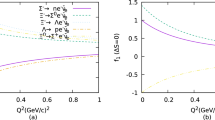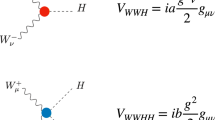Abstract
The particle production through the scalaron decays is considered for several different channels. The central part of the work is dedicated to a study of the decay probability into two complex minimally coupled massless scalars. The calculations are performed by two different independent methods. In addition we calculated the decay probability into real minimally coupled massless scalars, conformally coupled massive scalars, massive fermions, and gauge bosons. The results are compared with the published papers which in some cases disagree with each other.
Similar content being viewed by others
REFERENCES
A. A. Starobinsky, Phys. Lett. B 91, 99 (1980).
T. Faulkner, M. Tegmark, E. F. Bunn, and Y. Mao, Phys. Rev. D 76, 063505 (2007); astro-ph/0612569.
V. L. Ginzburg, D. A. Kirzhnits, and A. A. Lyubushin, Sov. Phys. JETP 33, 242 (1971).
A. D. Dolgov and Ya. B. Zeldovich, Rev. Mod. Phys. 53, 1 (1981).
E. Arbuzova, A. Dolgov, and R. Singh, Symmetry 13, 877 (2021).
E. V. Arbuzova, A. D. Dolgov, and R. S. Singh, J. Cosmol. Astropart. Phys. 07, 019 (2018); arXiv: 1803.01722 [gr-qc].
A. D. Dolgov and S. H. Hansen, Nucl. Phys. B 548, 408 (1999); hep-ph/9810428.
A. D. Dolgov and K. Freese, Phys. Rev. D 51, 2693 (1995); hep-ph/9410346.
E. V. Arbuzova, A. D. Dolgov, and L. Reverberi, J. Cosmol. Astropart. Phys. 02, 049 (2012); arXiv: 1112.4995 [gr-qc].
D. S. Gorbunov and A. G. Panin, Phys. Lett. B 700, 157 (2011); arXiv: 1009.2448 [hep-ph].
A. Vilenkin, Phys. Rev. D 32, 2511 (1985).
A. A. Grib, S. G. Mamayev, and V. M. Mostepanenko, Vacuum Quantum Effects in Strong Fields (Friedmann Labor., St. Petersburg, 1994) [in Russian].
A. D. Dolgov and D. P. Kirilova, Sov. J. Nucl. Phys. 51, 172 (1990).
C. Bambi and A. D. Dolgov, Introduction to Particle Cosmology (Springer, UNITEXT for Physics, 2015).
L. Parker, Phys. Rev. Lett. 21, 562 (1968).
L. Parker, Phys. Rev. 183, 1057 (1969).
A. D. Dolgov, Sov. Phys. JETP 54, 223 (1981).
G. F. Giudice, M. Peloso, A. Riotto, and I. Tkachev, J. High Energy Phys. 9908, 014 (1999); hep-ph/9905242.
ACKNOWLEDGEMENTS
This work was supported by the Russian Science Foundation under grant no. 22-12-00103.
Author information
Authors and Affiliations
Corresponding author
Ethics declarations
Data sharing is not applicable to this article as no datasets were generated or analyzed during the current study.
Appendices
Appendix
DESCRIPTION OF FERMIONS IN FLRW SPACE–TIME
Fermions in curved space–time are usually described in the tetrad formalism which is particularly simple for FLRW space–time. It is the conformally flat metric, which means that after introduction of conformal time (19) it is transformed into the form proportional to the flat Minkowski metric (20). Under this transformation Dirac equation for massless fermions becomes identical to the equation in flat space–time. So one can conclude that massless fermions cannot be produced by conformally flat gravitational field [15, 16].
In this section we calculate the probability of massive fermion production in FLRW metric following [14, 18]. The action for fermionic field \(\psi\) can be written as
where \(\sqrt{-g}=a^{3}\) is the metric determinant, \(\Gamma^{\mu}\) is a generalization of the Dirac \(\gamma^{\mu}\) matrices for curved space–time. In the FLRW metric they have the form \(\Gamma^{0}=\gamma^{0}\) and \(\Gamma^{i}=\gamma^{i}/a\) (\(i=1,2,3\)). They satisfy the anticommutation relations \(\{\Gamma^{\mu},\Gamma^{\nu}\}=2g^{\mu\nu}\), while \(\gamma^{\mu}\) are the usual Dirac matrices, obeying the anticommutation relation \(\{\gamma^{\mu},\gamma^{\nu}\}=2\eta^{\mu\nu}\). \(\nabla_{\mu}\) is the covariant derivative for the spin-1/2 field. In the FLRW metric it is equal to \(\nabla_{\mu}=\partial_{\mu}+(3/2)(\partial_{\mu}a)/a\).
The conformally transformed fermion field is defined as
In terms of conformal time \(\eta\) and field \(\psi_{\textrm{conf}}\) the action takes the form:
It is the action of a free fermion field in conformal coordinates with mass \(m_{\textrm{eff}}=m_{\psi}a(\eta)\).
The time dependence of the scale factor can be found from Eq. (3), see also Eq. (73):
where we have omitted unessential phase \(\theta\) and kept the main oscillating term, which is responsible for fermion production.
If we neglect the small and decreasing oscillating term, the scale factor as a function of \(t\) evolves as:
Here the subindex ‘‘bg’’ means background to distinguish it from total scale factor (A.4). Therefore,
Rights and permissions
About this article
Cite this article
Arbuzova, E.V., Dolgov, A.D. & Rudenko, A.S. Calculations of Scalaron Decay Probabilities. Phys. Atom. Nuclei 86, 266–276 (2023). https://doi.org/10.1134/S1063778823030031
Received:
Revised:
Accepted:
Published:
Issue Date:
DOI: https://doi.org/10.1134/S1063778823030031




